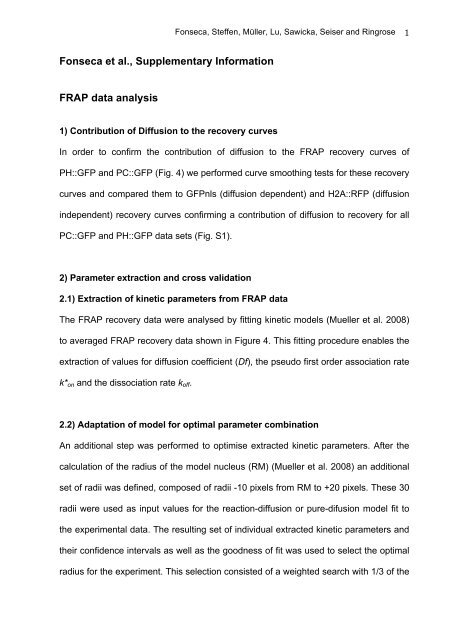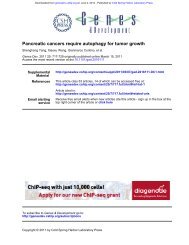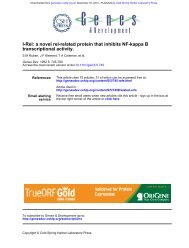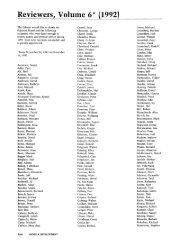Fonseca et al., Supplementary Information FRAP data analysis
Fonseca et al., Supplementary Information FRAP data analysis
Fonseca et al., Supplementary Information FRAP data analysis
You also want an ePaper? Increase the reach of your titles
YUMPU automatically turns print PDFs into web optimized ePapers that Google loves.
<strong>Fonseca</strong> <strong>et</strong> <strong>al</strong>., <strong>Supplementary</strong> <strong>Information</strong><br />
<strong>FRAP</strong> <strong>data</strong> an<strong>al</strong>ysis<br />
1) Contribution of Diffusion to the recovery curves<br />
<br />
<strong>Fonseca</strong>, Steffen, Müller, Lu, Sawicka, Seiser and Ringrose<br />
In order to confirm the contribution of diffusion to the <strong>FRAP</strong> recovery curves of<br />
PH::GFP and PC::GFP (Fig. 4) we performed curve smoothing tests for these recovery<br />
curves and compared them to GFPnls (diffusion dependent) and H2A::RFP (diffusion<br />
independent) recovery curves confirming a contribution of diffusion to recovery for <strong>al</strong>l<br />
PC::GFP and PH::GFP <strong>data</strong> s<strong>et</strong>s (Fig. S1).<br />
2) Param<strong>et</strong>er extraction and cross v<strong>al</strong>idation<br />
2.1) Extraction of kin<strong>et</strong>ic param<strong>et</strong>ers from <strong>FRAP</strong> <strong>data</strong><br />
The <strong>FRAP</strong> recovery <strong>data</strong> were an<strong>al</strong>ysed by fitting kin<strong>et</strong>ic models (Mueller <strong>et</strong> <strong>al</strong>. 2008)<br />
to averaged <strong>FRAP</strong> recovery <strong>data</strong> shown in Figure 4. This fitting procedure enables the<br />
extraction of v<strong>al</strong>ues for diffusion coefficient (Df), the pseudo first order association rate<br />
k*on and the dissociation rate koff.<br />
2.2) Adaptation of model for optim<strong>al</strong> param<strong>et</strong>er combination<br />
An addition<strong>al</strong> step was performed to optimise extracted kin<strong>et</strong>ic param<strong>et</strong>ers. After the<br />
c<strong>al</strong>culation of the radius of the model nucleus (RM) (Mueller <strong>et</strong> <strong>al</strong>. 2008) an addition<strong>al</strong><br />
s<strong>et</strong> of radii was defined, composed of radii -10 pixels from RM to +20 pixels. These 30<br />
radii were used as input v<strong>al</strong>ues for the reaction-diffusion or pure-difusion model fit to<br />
the experiment<strong>al</strong> <strong>data</strong>. The resulting s<strong>et</strong> of individu<strong>al</strong> extracted kin<strong>et</strong>ic param<strong>et</strong>ers and<br />
their confidence interv<strong>al</strong>s as well as the goodness of fit was used to select the optim<strong>al</strong><br />
radius for the experiment. This selection consisted of a weighted search with 1/3 of the<br />
1
<br />
<strong>Fonseca</strong>, Steffen, Müller, Lu, Sawicka, Seiser and Ringrose<br />
weight being given to the goodness of the confidence interv<strong>al</strong>s of association and<br />
dissociation constants, 1/3 to the goodness of the extracted diffusion constant<br />
confidence interv<strong>al</strong>, 1/6 to the size of the squared sum of residu<strong>al</strong>s and 1/6 to the<br />
distance from the initi<strong>al</strong> RM, with sm<strong>al</strong>ler distances being favoured. MATLAB files are<br />
available on request.<br />
2.3) Contribution of binding to <strong>FRAP</strong> recovery curves<br />
To ev<strong>al</strong>uate the role of binding in the recovery kin<strong>et</strong>ics we compared reaction-diffusion<br />
(3 extracted param<strong>et</strong>ers: Df, k*on and koff) and pure-difusion model fits (single extracted<br />
param<strong>et</strong>er: Df) as described in (Mueller <strong>et</strong> <strong>al</strong>. 2008) to our experiment<strong>al</strong> <strong>data</strong>. In <strong>al</strong>l<br />
cases shown in Figure 4, the best fit was given by the full reaction-diffusion model,<br />
indicating the presence of a bound fraction, and giving extracted v<strong>al</strong>ues for Df, k*on and<br />
koff.<br />
2.4) Cross-v<strong>al</strong>idation of extracted Df<br />
In addition to the extracted v<strong>al</strong>ues for Df from fitting the reaction- diffusion model, the<br />
Df for each protein in each cell type was measured independently. This was achieved<br />
by performing <strong>FRAP</strong> on the region of the m<strong>et</strong>aphase cell that is outside chromatin and<br />
fitting the pure diffusion model (Mueller <strong>et</strong> <strong>al</strong>. 2008) to the recovery <strong>data</strong>, giving an<br />
independent and direct measure of Df. Interphase v<strong>al</strong>ues were c<strong>al</strong>culated by<br />
conversion via diffusion coefficients measured for GFP by fitting the pure diffusion<br />
model to <strong>FRAP</strong> recovery curves measured in both interphase and m<strong>et</strong>aphase, (Table<br />
S1). The v<strong>al</strong>ues of Df thus measured showed excellent agreement with those<br />
extracted from fitting the full model (Figure S3).<br />
2
2.5) Robustness of extracted k*on, koff<br />
<br />
<strong>Fonseca</strong>, Steffen, Müller, Lu, Sawicka, Seiser and Ringrose<br />
The robustness of the extracted k*on and koff v<strong>al</strong>ues was examined by simulations<br />
performed at the v<strong>al</strong>ue of Df that was extracted from the reaction-diffusion model fit,<br />
and in which k*on and koff were varied, and the fit to experiment<strong>al</strong> <strong>data</strong> was ev<strong>al</strong>uated<br />
(Fig. S4). This an<strong>al</strong>ysis showed that for most <strong>data</strong> s<strong>et</strong>s, a limited range of k*on and koff<br />
v<strong>al</strong>ues gave optim<strong>al</strong> fits to the <strong>data</strong> (Fig. S4).<br />
3) Other models<br />
3.1) Loc<strong>al</strong>ised binding sites: m<strong>et</strong>aphase<br />
The effect of loc<strong>al</strong>ized binding sites in m<strong>et</strong>aphase was examined using the loc<strong>al</strong><br />
binding site model described in (Beaudouin <strong>et</strong> <strong>al</strong>. 2006; Sprague <strong>et</strong> <strong>al</strong>. 2006), showing<br />
that both the improved glob<strong>al</strong> binding (Mueller <strong>et</strong> <strong>al</strong>. 2008) and the loc<strong>al</strong>ized binding<br />
(Beaudouin <strong>et</strong> <strong>al</strong>. 2006; Sprague <strong>et</strong> <strong>al</strong>. 2006) models give essenti<strong>al</strong>ly identic<strong>al</strong> results<br />
in conditions of low binding, as is the case for the m<strong>et</strong>aphase <strong>data</strong> shown here (<strong>data</strong><br />
not shown). Unlike the Müller model (Mueller <strong>et</strong> <strong>al</strong>. 2008) the Sprague model<br />
(Beaudouin <strong>et</strong> <strong>al</strong>. 2006; Sprague <strong>et</strong> <strong>al</strong>. 2006) does not include consideration of the<br />
radi<strong>al</strong> bleach profile. Thus in order to achieve consistency of an<strong>al</strong>ysis, the Müller<br />
Model(Mueller <strong>et</strong> <strong>al</strong>. 2008) was used for an<strong>al</strong>ysis of <strong>al</strong>l <strong>data</strong> s<strong>et</strong>s.<br />
3.2) Non homogeneous distribution of proteins: interphase<br />
To test for the effect of non-homogeneity in protein distribution observed in interphase<br />
(Figure 2 and 3) on extracted kin<strong>et</strong>ic param<strong>et</strong>ers, we adapted the model described in<br />
(Mueller <strong>et</strong> <strong>al</strong>. 2008) from its origin<strong>al</strong> application to redistribution of photoactivatable<br />
3
<br />
<strong>Fonseca</strong>, Steffen, Müller, Lu, Sawicka, Seiser and Ringrose<br />
GFP, to render it applicable to the an<strong>al</strong>ysis of <strong>FRAP</strong> recovery curves, described here.<br />
Fitting this model to interphase <strong>data</strong> for individu<strong>al</strong> nuclei gave similar v<strong>al</strong>ues for the<br />
three extracted param<strong>et</strong>ers wh<strong>et</strong>her initi<strong>al</strong> distribution was assumed to be<br />
h<strong>et</strong>erogenous or homogenous (Figure S2).<br />
3.2.1) Generation of images of single nuclei.<br />
In order to construct input protein distribution images for param<strong>et</strong>er extraction, <strong>al</strong>l<br />
prebleach images of a single nucleus (250) were averaged and used to threshold the<br />
region of the nucleus in the tot<strong>al</strong> image. This region was selected to define the nucleus<br />
within the average image of 2s before photobleaching. Due to the speed of scanning, it<br />
was not feasible to image the entire nucleus. The shape of NB and SOP nuclei<br />
approximates well to a circle, thus the initi<strong>al</strong> binding site distribution in the entire<br />
nucleus was reconstructed from the image of the "equatori<strong>al</strong>" region, covering<br />
approximately 2/3 of the nucleus. On the resulting image a circle of radius RM (model<br />
nucleus radius c<strong>al</strong>culated as described in (Mueller <strong>et</strong> <strong>al</strong>. 2008) with adaptation as<br />
described in 2.1 above) was defined with the bleach region centered. This image was<br />
used to give the initi<strong>al</strong> distribution of binding sites in the nucleus. In order to produce<br />
the first postbleach image, a bleach pattern with param<strong>et</strong>ers describing the bleach<br />
spot profile was c<strong>al</strong>culated from the experiment<strong>al</strong> <strong>data</strong> (Mueller <strong>et</strong> <strong>al</strong>. 2008) and was<br />
superimposed on the prebleach image. Matlab files for image processing are available<br />
on request.<br />
3.2.2) Extraction of kin<strong>et</strong>ic param<strong>et</strong>ers from <strong>FRAP</strong> <strong>data</strong>, taking non<br />
homogeneous protein distribution into account.<br />
The intensity distribution images generated as described above were used as input for<br />
4
<br />
<strong>Fonseca</strong>, Steffen, Müller, Lu, Sawicka, Seiser and Ringrose<br />
fitting the spati<strong>al</strong> model described below to the individu<strong>al</strong> <strong>FRAP</strong> recovery curve for<br />
each nucleus, and extraction of param<strong>et</strong>ers. The spati<strong>al</strong> model was implemented in<br />
Mathematica (Wolfram) and is available on request.<br />
The reaction-diffusion system is simulated on a 2D circular domain, with a Neumann<br />
no-flux condition imposed on the boundary. The m<strong>et</strong>hod-of-lines is used to numeric<strong>al</strong>ly<br />
solve the resulting parti<strong>al</strong>-differenti<strong>al</strong> equation, where a second-order finite difference<br />
m<strong>et</strong>hod is used to discr<strong>et</strong>ize the diffusion operator on a uniform mesh. The spati<strong>al</strong><br />
discr<strong>et</strong>ization gives rise to a coupled system of ordinary differenti<strong>al</strong> equations for the<br />
free and bound concentrations at each mesh point, which is then numeric<strong>al</strong>ly<br />
integrated using an implicit solution scheme. The unknown param<strong>et</strong>ers in the model<br />
consist of: the diffusion constant Df, the off-rate of the reaction koff, and the ratio of the<br />
tot<strong>al</strong> amount of free molecules to bound molecules, Free. Given a v<strong>al</strong>ue for the free<br />
fraction, Free, the initi<strong>al</strong> conditions for the free and bound proteins are obtained from<br />
the smoothed, pre-bleached images. Given the v<strong>al</strong>ues of koff and Free, the spati<strong>al</strong>ly<br />
varying kon [C] is computed from the intensity distribution of the averaged chromatin<br />
images, following the m<strong>et</strong>hodology of (Mueller <strong>et</strong> <strong>al</strong>. 2008). In order to ensure the<br />
positivity of kon [C] in the model, a lower bound on the free fraction is imposed, whose<br />
v<strong>al</strong>ue is required to be greater than the minimum chromatin intensity over its average<br />
for the circular domain. The unknown param<strong>et</strong>ers (Df, koff, Free) are estimated from the<br />
measured fluorescence recovery curve for each individu<strong>al</strong> nucleus by solving the<br />
inequ<strong>al</strong>ity constrained optimization problem using the interior point m<strong>et</strong>hod. As starting<br />
v<strong>al</strong>ues for these three param<strong>et</strong>ers, the extracted v<strong>al</strong>ues from averaged <strong>data</strong> were used<br />
(Fig. 4, Table S1).<br />
5
<strong>Supplementary</strong> Legends<br />
<br />
<strong>Fonseca</strong>, Steffen, Müller, Lu, Sawicka, Seiser and Ringrose<br />
Figure S1. Diffusion influences <strong>FRAP</strong> recovery for GFPnls, PC::GFP, PH::GFP and<br />
H2A::RFP. Diffusion test was performed using an adaptation of the m<strong>et</strong>hod of curve<br />
smoothing (Mueller <strong>et</strong> <strong>al</strong>. 2008). (A-F) Radi<strong>al</strong> intensity profiles of <strong>FRAP</strong> experiments at<br />
four different time points after photobleaching (time in seconds is shown at the right of<br />
each plot). The gaussian edges of intensity profiles norm<strong>al</strong>ized to prebleach levels<br />
(Mueller <strong>et</strong> <strong>al</strong>. 2008) are plotted (symbols) and were fitted using linear regression (solid<br />
lines). The gray background indicates the bleach region. (A) H2A::RFP recovery is not<br />
affected by diffusion, indicated by similar slopes of lines at <strong>al</strong>l four time points.<br />
Comparison of the extracted slopes was performed using ANCOVA (p-v<strong>al</strong>ue given on<br />
each plot represents significance of difference b<strong>et</strong>ween slopes at the four time points).<br />
(B-F) GFP-nls, PC::GFP and PH::GFP <strong>FRAP</strong> recovery shows an influence of diffusion,<br />
indicated by gradu<strong>al</strong> flattening of radi<strong>al</strong> profiles at later time points. (E) Comparative<br />
summary plot. For <strong>data</strong> in (A-F), the v<strong>al</strong>ue 1/slope was c<strong>al</strong>culated for each linear fit<br />
and norm<strong>al</strong>ized to the slope at time 0. These v<strong>al</strong>ues are plotted for each <strong>data</strong> s<strong>et</strong> for<br />
consecutive time points, showing a gradu<strong>al</strong> increase in (1/slope) at later time points for<br />
<strong>al</strong>l experiments with the exception of H2A::RFP (black) for which little change was<br />
d<strong>et</strong>ected.<br />
Figure S2. Comparison of the effects of binding site non-homogeneity on param<strong>et</strong>ers<br />
extracted from <strong>FRAP</strong> experiments. Extracted diffusion (A,D,G and J), free fraction<br />
(B,E,H and K) and dissociation rates (koff, C,F,I and L) of PH::GFP (A-C, G-I) and<br />
PC::GFP (D-F, J-L) <strong>FRAP</strong> experiments in neuroblast interphase (A-F) and sensory<br />
organ precursor cell interphase (G-L) were an<strong>al</strong>ysed using an adaptation of the model<br />
described in (Mueller <strong>et</strong> <strong>al</strong>. 2008). (See <strong>Supplementary</strong> <strong>Information</strong>, <strong>FRAP</strong> Data<br />
6
<br />
<strong>Fonseca</strong>, Steffen, Müller, Lu, Sawicka, Seiser and Ringrose<br />
An<strong>al</strong>ysis, for d<strong>et</strong>ailed description). Black bars represent the mean and 95% confidence<br />
interv<strong>al</strong>s of the extracted param<strong>et</strong>ers using the same model with an initi<strong>al</strong><br />
homogeneous distribution of binding sites and grey bars represent the mean and 95%<br />
confidence interv<strong>al</strong>s of the extracted param<strong>et</strong>ers using the image-based<br />
h<strong>et</strong>erogeneous distribution of binding sites for each nucleus. n represents number of<br />
nuclei used in each experiment. 2-tailed paired t-tests were performed for each<br />
comparison resulting in p-v<strong>al</strong>ues > 0.05 with the exception of B (p=0.0001), C<br />
(p=0.0069), D (p=0.0282) and E (p=0.0163). Dashed lines represent param<strong>et</strong>ers<br />
extracted using the <strong>FRAP</strong> model described in (Mueller <strong>et</strong> <strong>al</strong>. 2008) and shown in<br />
Figure 4 and Table S1.<br />
Figure S3. Cross v<strong>al</strong>idation of extracted diffusion constants by independent<br />
measurements. (A) Comparison of diffusion constants extracted from fitting 3<br />
param<strong>et</strong>er <strong>FRAP</strong> model in <strong>al</strong>l cell types (Df (1), black) to diffusion constants c<strong>al</strong>culated<br />
by fitting single param<strong>et</strong>er <strong>FRAP</strong> model (diffusion only) to <strong>FRAP</strong> recovery performed<br />
on the non-chromatin volume in m<strong>et</strong>aphase (Df (2), grey). The interphase Df v<strong>al</strong>ues<br />
(grey) were c<strong>al</strong>culated using GFPnls for c<strong>al</strong>ibration as described in <strong>Supplementary</strong><br />
<strong>Information</strong>. The Df v<strong>al</strong>ues c<strong>al</strong>culated by the two procedures show good agreement.<br />
NB and SOP indicate neuroblast and SOP interphase and NBm<strong>et</strong> and SOPm<strong>et</strong><br />
indicate neuroblast and SOP m<strong>et</strong>aphase. pIIa and pIIb indicate the interphase of the<br />
respective cells. Data show mean of at least four measurements for each cell type.<br />
Error bars represent 95% confidence interv<strong>al</strong>s. (B) Estimated molecular weight of<br />
PH::GFP and PC::GFP in neuroblasts (black) and SOPs (grey). Estimations were<br />
based on the extracted Df for GFPnls, PH::GFP and PC::GFP in regions outside<br />
chromatin at m<strong>et</strong>aphase in neuroblasts and SOPs and c<strong>al</strong>culated using the following<br />
7
<br />
<strong>Fonseca</strong>, Steffen, Müller, Lu, Sawicka, Seiser and Ringrose<br />
equation: Mwprotein = MwGFP /(Dfprotein/DfGFP)^3. The Mw estimated for PC::GFP is<br />
consistent with the predicted size of the PRC1 complex. In contrast, the Mw estimated<br />
for PH::GFP is approximately 15MDa. The PH protein has not been reported to<br />
participate in such large complexes, thus this result suggests that the extracted<br />
diffusion constant for PH::GFP may comprise both the true diffusion and a binding<br />
component (Mueller <strong>et</strong> <strong>al</strong>. 2008) .<br />
Figure S4. Param<strong>et</strong>er space for best fits of <strong>FRAP</strong> model to recovery <strong>data</strong>. For each<br />
<strong>FRAP</strong> recovery <strong>data</strong> s<strong>et</strong> shown in Figure 4, simulations were performed in which Df<br />
was fixed to the v<strong>al</strong>ue extracted from the 3 param<strong>et</strong>er fit (Fig. S3a, grey bars; Table<br />
S1), and k*on and koff were varied b<strong>et</strong>ween 10 -4 and 10. For each simulation, the fit to<br />
the experiment<strong>al</strong> <strong>data</strong> was ev<strong>al</strong>uated as squared sum of residu<strong>al</strong>s (ssrs). The white,<br />
red or black lines delineate ssrs 1.25 times larger than the minimum ssr found. Top<br />
row: interphase and m<strong>et</strong>aphase best fit regions from each <strong>data</strong> s<strong>et</strong> as indicated above<br />
the plots, are superimposed for comparison. Below: ssrs for each <strong>data</strong> s<strong>et</strong> are plotted<br />
individu<strong>al</strong>ly as heat maps (colour sc<strong>al</strong>e for ssrs is shown at the right of the plot.)<br />
Figure S5. Dot blot an<strong>al</strong>ysis of α-H3K27me3S28ph antibody. Seri<strong>al</strong> dilutions of<br />
synth<strong>et</strong>ic peptides corresponding to N-termin<strong>al</strong> sequence of histone H3 (amino acids<br />
19-37), with different S28 phosphorylation and K27 m<strong>et</strong>hylation status as indicated<br />
above the figure, were spotted on a PVDF membrane and probed with the α-<br />
H3K27me3S28ph antibody (dilution 1: 20000). For d<strong>et</strong>ection a secondary anti rabbit<br />
horseradish peroxidase-conjugated antibody and the Enhanced Chemiluminescence<br />
(ECL) d<strong>et</strong>ection system were used. To ensure equ<strong>al</strong> peptide loading, a duplicate<br />
membrane was stained with Ponceau S.<br />
8
<br />
<strong>Fonseca</strong>, Steffen, Müller, Lu, Sawicka, Seiser and Ringrose<br />
Movie S1. PH::GFP in neuroblast. Green channel: PH::GFP under the worniu-GAL4<br />
driver is visu<strong>al</strong>ized in neuroblast and ganglion mother cells (GMCs). Red channel:<br />
Histone H2A::RFP is expressed under the ubiqutin promoter and visu<strong>al</strong>ized in <strong>al</strong>l cells.<br />
RFP marked chromatin becomes visible in the neuroblast at mitosis. The movie starts<br />
at interphase; the largest cell is the neuroblast. One mitotic division up to the next<br />
telophase is shown.<br />
Movie S2. PC::GFP in neuroblast. Green channel: PC::GFP is expressed under the<br />
Pc promoter and is visu<strong>al</strong>ized in <strong>al</strong>l cells. Red channel: Histone H2A::RFP is<br />
expressed under the ubiqutin promoter and visu<strong>al</strong>ized in <strong>al</strong>l cells. RFP marked<br />
chromatin becomes visible in the neuroblast at mitosis. The movie starts at interphase;<br />
the largest cell is the neuroblast. One mitotic division up to the next telophase is<br />
shown.<br />
Movie S3. PH::GFP in SOP. Both PH::GFP (green channel) and histone H2A::RFP<br />
were expressed under the neur<strong>al</strong>ized-GAL4 driver and are visible in specific<strong>al</strong>ly in the<br />
SOP and its daughter cells pIIa and pIIb. RFP marked chromatin is visible at <strong>al</strong>l<br />
stages. The movie starts at SOP interphase. One mitotic division up to the next<br />
interphase is shown. At the end of the movie, the two daughter cells pIIa and pIIb are<br />
seen.<br />
Movie S4. PC::GFP in SOP. Green channel: PC::GFP is expressed under the Pc<br />
promoter and is visu<strong>al</strong>ized in <strong>al</strong>l cells. Red channel: histone H2A::RFP was expressed<br />
under the neur<strong>al</strong>ized-GAL4 driver and is visible in specific<strong>al</strong>ly in the SOP and its<br />
9
<br />
<strong>Fonseca</strong>, Steffen, Müller, Lu, Sawicka, Seiser and Ringrose 10 <br />
daughter cells pIIa and pIIb. RFP marked chromatin is visible at <strong>al</strong>l stages. The movie<br />
starts at SOP interphase. The SOP is the largest cell and the only one showing red<br />
sign<strong>al</strong>. One mitotic division up to the next interphase is shown. At the end of the<br />
movie, the two daughter cells pIIa and pIIb are seen.<br />
Table S1. Compilation of measured and extracted param<strong>et</strong>ers of PH::GFP, PC::GFP<br />
and GFPnls in Neuroblast interphase (NB) and m<strong>et</strong>aphase (NBm<strong>et</strong>), SOP interphase<br />
(SOP) and m<strong>et</strong>aphase (SOPm<strong>et</strong>), pIIa interphase (pIIa) and pIIb interphase (pIIb). For<br />
the quantification param<strong>et</strong>ers, volume measurements in cubic microm<strong>et</strong>ers,<br />
d<strong>et</strong>ermined by GFP fluorescence (Blue masks in Figure 2 and 3), are shown (A) as<br />
well as number and micromolar concentrations of GFP-fused (B, C), endogenous (D,<br />
E) and endogenous in yw flies (F,G) molecules of PH and PC. Kin<strong>et</strong>ic param<strong>et</strong>ers<br />
extracted using the m<strong>et</strong>hod described in (Mueller <strong>et</strong> <strong>al</strong>. 2008) are shown in the section<br />
Kin<strong>et</strong>ic param<strong>et</strong>ers. The radius used for the param<strong>et</strong>er extraction is shown in µm (H).<br />
(I) represents the extracted diffusion from the full model (3 param<strong>et</strong>er fit) for PH::GFP<br />
and PC::GFP and from the pure diffusion model (single param<strong>et</strong>er fit) for GFPnls. (J)<br />
represents the extracted diffusion from the pure diffusion model in regions outside<br />
chromatin in NBm<strong>et</strong> and SOPm<strong>et</strong>, and the estimated PH::GFP and PC::GFP diffusions<br />
in interphase of <strong>al</strong>l other cell types through the comparison with GFPnls diffusions<br />
(Fig.S3). Residence time (M) was c<strong>al</strong>culated as (1/K). The fraction of bound molecules<br />
in the chromatin region (N) was c<strong>al</strong>culated by the following equation: 100*(L)/(L+M).<br />
The tot<strong>al</strong> fraction of bound molecules (O) was c<strong>al</strong>culated with the following equation:<br />
(N)*(T)/(B). (T) represents the number of GFP-fused proteins that are loc<strong>al</strong>ized in the<br />
region d<strong>et</strong>ermined by H2A::RFP fluorescence (Yellow masks in Figures 2 and 3).<br />
Number of bound GFP-fused (P), GFP-fused and endogenous (Q) and endogenous in
<br />
<strong>Fonseca</strong>, Steffen, Müller, Lu, Sawicka, Seiser and Ringrose 11 <br />
yw flies (R) molecules are shown. In the Image-based param<strong>et</strong>ers section are listed<br />
the volume in cubic microm<strong>et</strong>ers occupied by chromatin (S) and the number of GFP<br />
proteins that are in this volume (T). As (T), (S) was d<strong>et</strong>ermined by H2A::RFP<br />
fluorescence. The c<strong>al</strong>culated fraction of bound molecules in the chromatin region,<br />
without the assumption of equilibrium, according to equation 18 of <strong>Supplementary</strong><br />
<strong>Information</strong> – Mathematic<strong>al</strong> modeling is listed as (U). The number of GFP-fused<br />
proteins bound to chromatin is listed as (W). The tot<strong>al</strong> fraction of bound molecules (V)<br />
was c<strong>al</strong>culated with the ratio W/B. In the Modelling param<strong>et</strong>ers section are listed the<br />
param<strong>et</strong>ers used for the model shown in Figure 5: pseudo-first order association rate<br />
(X), the dissociation rate (Y) the number of endogenous Polycomb proteins (Z), as well<br />
as the cell (AA) and chromatin (AB) volumes. These param<strong>et</strong>ers were selected from<br />
the experiment<strong>al</strong>ly d<strong>et</strong>ermined v<strong>al</strong>ues listed in (L), (K), (F), (A) and (S). Also shown<br />
are the assumed number of binding sites (AC), representing the maximum possible<br />
number of H3K27 m<strong>et</strong>hylated tails in the diploid genome based on H3K27me3<br />
distributions in polytene chromosomes and genome-wide ChIP profiles, assuming<br />
m<strong>et</strong>hylation of <strong>al</strong>l H3 tails within a region of H3K27me3 sign<strong>al</strong>. Based on this number<br />
of binding sites, the c<strong>al</strong>culated micromolar dissociation constant (AD) is shown.<br />
184648, FigureS1, <strong>Fonseca</strong><br />
A<br />
Norm<strong>al</strong>ised Intensity<br />
B<br />
Norm<strong>al</strong>ised Intensity<br />
C<br />
Norm<strong>al</strong>ised Intensity<br />
D<br />
Norm<strong>al</strong>ised Intensity<br />
1.2<br />
1.0<br />
0.8<br />
0.6<br />
1.0<br />
0.8<br />
0.6<br />
0.4<br />
1.0<br />
0.8<br />
0.6<br />
0.4<br />
1.0<br />
0.8<br />
0.6<br />
H2A::RFP - SOP<br />
P=0.1087<br />
0.5 1.0<br />
Radius ( m)<br />
1.5<br />
GFPnls - SOP<br />
P=0.0013<br />
1.0 1.5<br />
Radius ( m)<br />
PC::GFP - SOP<br />
P
NB PH<br />
NB PC<br />
SOP PH<br />
SOP PC<br />
184648, Figure S2, <strong>Fonseca</strong><br />
D f (µm 2 .s -1 )<br />
D f (µm 2 .s -1 )<br />
D f (µm 2 .s -1 )<br />
D f (µm 2 .s -1 )<br />
Diffusion Free Fraction koff A B C<br />
5<br />
4<br />
3<br />
2<br />
1<br />
0<br />
Homogeneous H<strong>et</strong>erogeneous<br />
n = 5<br />
10<br />
8<br />
6<br />
4<br />
2<br />
0<br />
1.5<br />
1.0<br />
0.5<br />
0.0<br />
10<br />
8<br />
6<br />
4<br />
2<br />
0<br />
Homogeneous H<strong>et</strong>erogeneous<br />
Homogeneous H<strong>et</strong>erogeneous<br />
Homogeneous H<strong>et</strong>erogeneous<br />
n = 14<br />
n = 6<br />
n = 6<br />
Free Fraction<br />
Free Fraction<br />
Free Fraction<br />
Free Fraction<br />
1.0<br />
0.8<br />
0.6<br />
0.4<br />
0.2<br />
0.0<br />
1.0<br />
0.8<br />
0.6<br />
0.4<br />
0.2<br />
0.0<br />
0.8<br />
0.6<br />
0.4<br />
0.2<br />
0.0<br />
1.0<br />
0.8<br />
0.6<br />
0.4<br />
0.2<br />
0.0<br />
Homogeneous H<strong>et</strong>erogeneous<br />
D E F<br />
Homogeneous H<strong>et</strong>erogeneous<br />
G H I<br />
Homogeneous H<strong>et</strong>erogeneous<br />
J K L<br />
Homogeneous H<strong>et</strong>erogeneous<br />
n = 5<br />
n = 14<br />
n = 6<br />
n = 6<br />
k off (s -1 )<br />
k off (s -1 )<br />
k off (s -1 )<br />
k off (s -1 )<br />
10<br />
1<br />
0.1<br />
0.01<br />
10<br />
1<br />
0.1<br />
10<br />
1<br />
0.1<br />
0.01<br />
10<br />
1<br />
0.1<br />
0.01<br />
0.001<br />
Homogeneous H<strong>et</strong>erogeneous<br />
Homogeneous H<strong>et</strong>erogeneous<br />
Homogeneous H<strong>et</strong>erogeneous<br />
Homogeneous H<strong>et</strong>erogeneous<br />
n = 5<br />
n = 14<br />
n = 6<br />
n = 6
184648, Figure S3, <strong>Fonseca</strong><br />
A<br />
D f (µm 2 .s -1 )<br />
B<br />
Estimated MW (kDa)<br />
6<br />
4<br />
2<br />
0<br />
PH NB<br />
PH NBm<strong>et</strong><br />
100000<br />
10000<br />
1000<br />
100<br />
10<br />
1<br />
PH SOP<br />
Df (1)<br />
Df (2)<br />
PH SOPm<strong>et</strong><br />
PH pIIa<br />
PH pIIb<br />
PC NB<br />
PC NBm<strong>et</strong><br />
PC SOP<br />
PC SOPm<strong>et</strong><br />
PC pIIa<br />
Polycomb Polyhomeotic<br />
PC pIIb<br />
NB<br />
SOP
184648, Figure S4, <strong>Fonseca</strong>
184648, Figure S5, <strong>Fonseca</strong><br />
50 pmol<br />
10 pmol<br />
2 pmol<br />
Ponceau S (50 pmol)<br />
H3 unmodified<br />
H3 S28ph<br />
H3K27me3<br />
H3K27meS28ph<br />
H3K27me2S28ph<br />
H3K27me3S28ph<br />
H3K9me3S10ph
Section Variable ID Variable NB NBm<strong>et</strong> SOP SOPm<strong>et</strong> pIIa pIIb NB Nbm<strong>et</strong> SOP SOPm<strong>et</strong> pIIa pIIb NB Nbm<strong>et</strong> SOP SOPm<strong>et</strong> pIIa pIIb<br />
Image-based param<strong>et</strong>ers Kin<strong>et</strong>ic param<strong>et</strong>ers<br />
Quantification<br />
Modeling param<strong>et</strong>ers<br />
PH::GFP PC::GFP<br />
A Volume (µm 3 ) 239.55 ± 26.43 682.99 ± 97.67 149.26 ± 12.12 752.52 ± 31.53 72.71 ± 2.65 53.86 ± 4.40 176.33 ± 9.56 726.72 ± 74.88 171.60 ± 5.94 590.66 ± 37.02 97.15 ± 11.59 68.62 ± 9.76<br />
B # GFP 139409 ± 16220 74930 ± 8811 119147 ± 25089 133038 ± 22613 37372 ± 2367 25656 ± 2059 73350 ± 8201 118877 ± 12065 37461± 3090 39228 ± 3145 20902 ± 2222 14749 ± 1484<br />
C µM GFP 0.98 ± 0.06 0.19 ± 0.03 1.36 ± 0.39 0.29 ± 0.04 0.86 ± 0.02 0.80 ± 0.01 0.70 ± 0.08 0.27 ± 0.02 0.36 ± 0.02 0.11 ± 0.01 0.36 ± 0.03 0.36 ± 0.03<br />
D # end 24369 ± 2725 39494 ± 4008 20359 ± 1679 21320 ± 1709 11360 ± 1208 8015 ± 807<br />
E µM end 0.23 ± 0.03 0.09 ± 0.01 0.20 ± 0.01 0.06 ± 0.002 0.20 ± 0.01 0.20 ± 0.02<br />
F # end yw 40615 ± 9306 65823 ± 14762 48474 ± 13310 50762 ± 13904 27048 ± 7646 19083 ± 5355<br />
G µM end yw 0.38 ± 0.09 0.15 ± 0.03 0.48 ± 0.13 0.14 ± 0.04 0.48 ± 0.13 0.48 ± 0.13<br />
H Radius (µm) 2.27 4.38 2.86 3.43 2.28 2.28 2.99 3.45 2.91 6.36 2.37 2.19 4.19 8.18 2.91 5.52 2.78 2.80<br />
I Df 1 (µm 2 .s -1 ) 1.05 ± 0.17 1.26 ± 0.15 0.76 ± 0.23 1.52 ± 0.56 1.12 ± 0.31 1.11 ± 0.43 5.10 ± 0.92 2.17 ± 0.45 3.00 ± 0.34 2.43 ± 0.30 2.42 ± 0.38 2.90 ± 0.35 11.43 ± 0.96 10.50 ± 0.45 8.17 ± 0.64 9.15 ± 0.50 6.82 ± 0.72 5.77 ± 0.61<br />
J Df 2 (µm 2 .s -1 ) 1.14 ± 0.07 1.05 ± 0.06 0.68 ± 0.05 0.77 ± 0.06 0.57 ± 0.04 0.48 ± 0.04 3.41 ± 0.41 3.13 ± 0.38 2.80 ± 0.17 2.53 ± 0.15 2.33 ± 0.14 1.97 ± 0.12<br />
K k off (s -1 ) 0.23 ± 0.05 0.002 ± 0.0007 0.10 ± 0.01 0.24 ± 0.06 0.15 ± 0.01 0.13 ± 0.01 2.19 ± 0.75 0.30 ± 0.18 0.72 ± 0.40 0.002 ± 0.0007 0.24 ± 0.11 0.27 ± 0.14<br />
L k* on (s -1 ) 0.10 ± 0.04 0.0001 ± 0.00005 0.13 ± 0.04 0.15 ± 0.08 0.29 ± 0.05 0.27 ± 0.06 0.51 ± 0.38 0.06 ± 0.06 0.08 ± 0.08 0.0003 ± 0.00003 0.07 ± 0.04 0.04 ± 0.03<br />
M Rtime (s) 4.26 607.72 9.77 4.17 6.52 7.78 0.46 3.35 1.39 431.33 4.10 3.72<br />
N Fbound chr (%) 29.67 7.78 56.59 37.87 65.74 67.82 18.93 17.60 10.44 9.78 21.92 13.29<br />
O Fbound tot<strong>al</strong> (%) 29.67 0.41 56.59 1.81 65.74 67.82 18.93 0.53 10.44 0.94 21.92 13.29<br />
P # GFP bound 41360 ± 4812 310 ± 36 67421 ± 14197 2410 ± 410 24569 ± 1556 17399 ± 1396 13885 ± 1552 627 ± 64 3912 ± 321 367 ± 29 4581 ± 487 1960 ±197<br />
Q #GFP + end bound 18498 ± 2068 835 ± 85 6038 ± 496 566 ± 45 7070 ± 752 3026 ± 304<br />
R # end bound yw 7688 ± 860 347 ± 35 5062 ± 416 475 ± 38 5928 ± 630 2537 ± 255<br />
S Volume chr (µm 3 ) 33.24 31.58 14.15 30.59<br />
T # GFP chr 3,977 6,365 3,562 3,750<br />
U Fbound chr (%) 8.73 12.84 35.74 48.32<br />
V Fbound tot<strong>al</strong> (%) 0.46 0.61 1.07 4.62<br />
W # GFP chr bound 347 817 1273 1,812<br />
X k* 1 (s -1 ) 0.51 0.06 0.08 0.0003 0.06856 0.041193<br />
Y k -1 (s -1 ) 2.19 0.3 0.72 0.002 0.24429 0.26871<br />
Z # PC 40615 1216 48474 4633 27048 19083<br />
AA Volume Cell (µm3) 176.33 14.15 171.60 30.59 97.15 68.62<br />
AB Volume Chr (µm3) 176.33 14.15 171.60 30.59 97.15 68.62<br />
AC # chromatin sites 80000 80000 80000 80000 80000 80000<br />
AD Kd (µM) 11.23 35.04 18.28 36.67 7.71 14.13<br />
GFPnls







